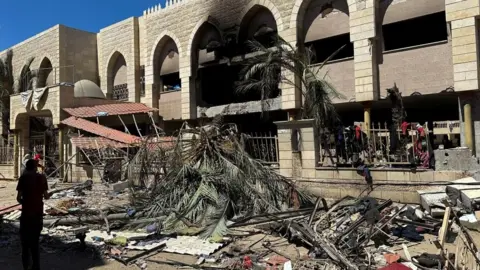More than 70 people were killed in an Israeli airstrike on a school building housing Palestinian migrants in the Gaza Strip, the hospital’s director told the BBC.
Fadl Naim, director of Al Ahli Hospital where many of the casualties were reported, said the victims had been identified so far, but many other remains were too badly damaged to be identified.
An Israeli military spokesman said the al-Tabain school was “used as an active military facility by Hamas and Islamic Jihad,” a charge Hamas denies.
The strikes were criticized by Western powers and regional countries, which claimed they showed Israel was unwilling to sign a ceasefire or end the Gaza war.
Israel has attacked several of these shelters in the Gaza Strip in recent weeks.
According to the UN, as of July 6, 477 of the 564 school buildings in the Gaza Strip had been directly attacked or damaged, and 12 more have been attacked since then.
The Al-Tabain school accommodates more than 1,000 people. The school recently housed dozens of displaced people from the village of Beit Hanoun after the Israeli army ordered them to leave their homes.
Witnesses said the building also served as a mosque and that the Israeli strike came during dawn prayers.
Jafar Taha, a student who lives near the school, told the BBC he heard screams and noise followed by the sound of the bomb.
“‘Save us, save us,’ they shouted,” he said.
“The scene was horrific. There were body parts everywhere and the walls were covered in blood.”
Saleem Owais, a spokesman for the UN children’s agency UNICEF, told the BBC the attack was “absolutely outrageous”.
“All the schools are full of citizens, children, mothers, families. They seek refuge in any empty space, whether it is a school, a mosque, any place, even a hospital yard.”
The Israeli military said it “targeted Hamas terrorists operating from the Hamas command and control center located at the al-Tabain school with precision.”
“According to Israeli intelligence, approximately 20 Hamas and Islamic Jihad militants, including senior commanders, are operating from the compound that attacked the al-Tabain school and carrying out terrorist attacks,” IDF spokesman Lt. Col. Nadav Shoshani said in a statement.
The IDF and Israeli security services later said in a statement that “at least 19 Hamas and Islamic Jihad terrorists” were “killed” in the attack.
The Hamas-run health ministry’s ambulance service said more than 60 people were killed, according to the AP, with early estimates of the death toll in the dozens. The civil defense agency put the death toll at more than 90.
The BBC cannot independently verify either figure.
An Israeli spokesman said the casualty figures released by Hamas officials “do not correspond to the information held by the IDF, the exact munitions used, or the accuracy of the strikes.”
Hamas described the attack as a “horrific crime and a dangerous escalation” in Israel’s “war of genocide against the Palestinian people.”
Fatah, Hamas’ political Palestinian rival in the Israeli-occupied West Bank, has said Israel’s goal is “to eradicate the Palestinian people through a policy of cumulative killings.”
The United States has expressed “deep concern” over reports of civilian casualties and is demanding more details.
A U.S. National Security Council spokesman said: “We know that Hamas has used schools as meeting places and for operations.
“But we have consistently said that Israel must take steps to minimize civilian casualties.”
“Too many civilians continue to be killed and injured,” he added, “which underscores the urgency of a ceasefire and hostage negotiations.”
“It is time to put an end to these horrors that are unfolding on our watch,” said Philippe Lazzarini, head of UNRWA, the UN agency that helps Palestinians.
The French Foreign Ministry said it condemned the strike “in the strongest terms.”
“School buildings have been repeatedly attacked over several weeks, resulting in intolerable civilian casualties,” the report said.
Israel must respect international humanitarian law,” he added.
British Foreign Secretary David Lammy said he was “shocked” by the “tragic loss of life” and stressed the need for an “immediate ceasefire”.
 Reuters
ReutersThis latest airstrike has once again brought into sharp focus the controversial dynamics of war.
Israel claims Hamas plans and carries out attacks using civilian infrastructure, which is why it is targeting hospitals and schools protected by international law.
Hamas has repeatedly denied these accusations.
In any case, these two places are where Gaza residents who lost their homes due to the conflict have sought refuge. The schools in particular are shelters, with more than 80% directly affected or damaged.
Israel has carried out at least 13 airstrikes since early July, four of them over a four-day period, and has declared that each strike involves measures to reduce the risk of harm to civilians, including the use of precision weapons.
Many of the schools were run by the United Nations before the war, and the UN strongly condemned the strike.
This appears to be a particularly catastrophic incident. While pressure for a ceasefire will undoubtedly grow, the response from regional mediators suggests that efforts to achieve a ceasefire could be further derailed.
Egypt, one of the mediators, said Israel’s “deliberate killing” of unarmed Palestinians showed Israel’s lack of political will to end the war.
Qatar, which took part in the ceasefire talks, also called for an urgent international investigation.
Hamas-led militants attacked Israel on October 7, killing about 1,200 people and taking 251 hostages to the Gaza Strip.
The attack triggered a massive Israeli military offensive against the Gaza Strip, and the war continues today.
According to the Hamas-run health ministry in Gaza, more than 39,790 Palestinians have been killed in Israeli airstrikes.
Additional reporting by Gaza Correspondent Rushdi Abualouf in Istanbul, Turkey

